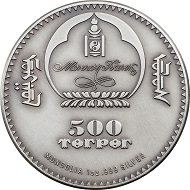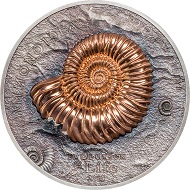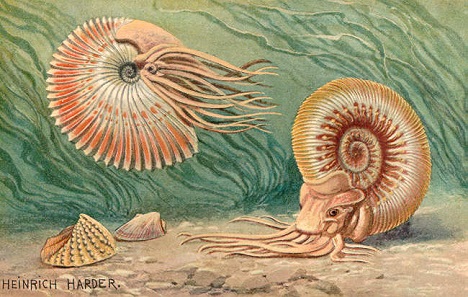March 3, 2016 – For some 350 million years, Ammonites populated the ocean before they became extinct about 65 million years ago, together with the dinosaurs. Aficionados of fossils and coins alike will be intrigued by the creation of Coin Invest Trust which, on behalf of Mongolia, commemorates these fascinating molluscs with a coin.
Mongolia / 500 Togrog / Silver .999 / 1 oz / 38.61 mm / Mintage: 999.
The obverse shows the coat of arms of the issuing state, below, the nominal value. Engraved around the bottom rim are weight and fine content and, in the silver edition, the name of the issuing state.
The reverse of the gold coin features an Ammonite fossil in high-relief, the silver coin one with a red-golden finish. In addition to the year of issue, the former bears the inscriptions EVOLUTION and AMMONITE, the latter (silver coin) EVOLUTION OF LIFE, AMMONOIDEA, and DEVONIAN PERIOD.
Historic reconstruction of ammonites by Heinrich Harder (1858-1935).
For some 350 million years, between the Devonian and the Cretaceous, Ammonites populated the ocean in many different shapes and species. They became extinct about 65 million years ago, together with the dinosaurs. Today, Ammonites, which were often as big as 30 cm, serve as index fossils which are used to link rock layers to geological time periods. The molluscs belong to the class of the Cephalopods, which also includes the still extant Nautilus.
The subclass Ammonoidea, first scientifically described by Karl Alfred von Zittel in 1884, is related to the octopus and the squid. Ammonites used the chambers inside their spiralled shells to pump water in and out, enabling them to move forward under water just like a submarine and escape the mosasaur, the dominant marine predator at the time.
Today, collectors enjoy the countless fossilized Ammonites, already known to Pliny the Elder, that have been preserved: Once the animal dies its soft tissue dissolves and sand or minerals begin to accumulate on the shell, which gradually hardens over time.
Further, Ammonites, sometimes found in a special rock formation consisting of fossilized Ammonite lime shells and referred to as “shell marble”, are also used for jewellery or table inlays. Pyritized Ammonites are especially popular. Their nickname “gold snails” is taken up in the red-golden finish of the silver issue in the “Evolution of Life – Ammonite” series.
The coins were minted by B. H. Mayer’s Kunstprägeanstalt GmbH. Collectors can purchase the issues through specialty dealers.
Further information about Evolution of Life 2015 – Ammonite is available here and here.
This is the website of Coin Invest Trust.
A wealth of information about Ammonoidea can be found in this database.
And here you can read about a recent major Ammonites find at Dorset/UK.






